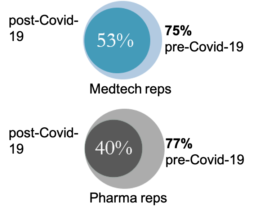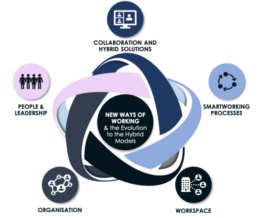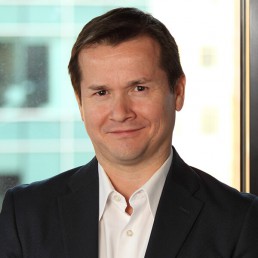Future of work: healthcare med reps transformation
In his latest blog post relating to Future of Work, Curzon’s Managing Consultant Rodrigo Quezada Dighero focuses on the transformation of healthcare medical sales reps.
Exploring how the pandemic has disrupted the face-to-face salesforce, and the unique opportunity this presents to adapt the operating model for future success.
The effectiveness of a disrupted salesforce
One year into the pandemic and face-to-face sales look very different from 12 months ago. Medical Reps are facing exceptional challenges in reaching their sales targets, as restrictions on in-person meetings with HCPs continue.
The gravity of the situation is reflected in the 16 new drugs launched during COVID-19 lockdowns, that are at risk of sales failures, according to one pharma consulting group.
However, the lifting of lockdowns is unlikely to return the industry back to ‘normal’. In fact, the evidence shows a stark reality for in-person sales.
-
About 60% of surgeons believe that restrictions on in-person sales are likely to remain even after a Covid-19 vaccine is available and lockdown restrictions abate.
Percentage who believe restrictions on face-to-face visits are likely to continue after Covid-19

Moreover, the changing landscape is not just a result of the pandemic; it’s expedited the necessary changes, but fundamentally, companies have been very slow to adapt their operating models to address the needs and wants of their customers and workforce.
-
Of the 75% of physicians who preferred in-person visits from Medtech representatives prior to Covid-19, 47% would now opt for a virtual exchange or less-frequent visits.
-
Many physicians once sceptical of any virtual interaction with sales reps now report these exchanges are high quality and offer a much better experience.
Healthcare providers are demanding more from pharma, as they seek greater value from their interactions with Med Reps.
-
69% of doctors now want digital patient education
-
67% want more education on remote patient care
-
65% need specific information on conditions relative to COVID-19
-
65% require information to help patients access labs, tests and imaging
It’s clear as medical professionals endure the uncertainty caused by COVID-19, changes are here to stay, and adaptation is crucial to success.
Identifying the opportunity - a new way of working
Digitalisation has accelerated the Next Normal requiring pharma operating models to adapt, or in some cases, completely transform to help them to thrive or even survive.
In this context, the need to provide refined, enriched collateral to healthcare providers and doctors demands an evolution from face-to-face meetings and conferences into a hybrid exchange of virtual and in-person meetings, steered by medical reps.
Percentages of doctors who prefer in-person sales visits

However, in order for this to be fully realised, pharma companies need to adjust and develop their salesforce capabilities. In another study, research shows that only 26% of pharma reps get coaching personalised to their needs. A focus on sales coaching, through integrated, personalised and value-driven interactions will support med reps to identify target prospects and align the products to the needs of the HPC, through their preferred communication channel.
Moreover, managers and leaders need to align sales & marketing, to ensure a collaborative approach to fully understand the customers and the local market they operate in. Communication and insight must flow both ways to drive communication strategies, content creation and support product development.
Our approach
Our approach to New Ways of Working accelerates the adaptation to the digital business model, focusing on the delivery of required capabilities and the evolution towards a hybrid model.
For this specific transformation, we focus on four of the five key areas
-
Organisation
-
Collaboration and Hybrid Solutions
-
Smartworking Processes
-
People & Leadership

Organisation
- Develop strategies that assist medical reps throughout the sales process, tailored to every customer touchpoint.
- Establish hybrid teams that can develop relevant, channel-specific, timely content to empower the med reps.
- Foster internal engagement and alignment by creating a purpose-based organisation with a relentless focus on value-add customer service.
- Entrench company culture to sustain new ways of working and improve business agility – always listening… constantly evolving.
Collaboration & Hybrid Solutions
The virtual nature of teams and work communities spearheads the need to adopt solutions that enhance and facilitate effective remote interactions.
- Optimise team relationships, roles & interactions to enhance hybrid ways of working.
- Design and implement collaboration solutions applied to the business and team leadership.
- Adopt collaborative tools, enabling sales & marketing teams to share opportunities that improve the quality of exchanges, content creation and value-based interactions regardless of location.
Smartworking Processes
Achieving process transformation through re-engineering & automation to create a generation of agile, flexible, efficient and collaborative working dynamics.
- Redesign smartworking processes, harnessing automation and flexibility to accelerate change and bring the hybrid model alive.
- Employ digital tools to evolve sales, HCP engagement and bring the customer experience to the forefront of every interaction.
- Remove silos to cultivate employee engagement and shared knowledge/opportunities.
People & Leadership
Evolution of culture and people is the foundation of Digital Transformation enabling leaders of pharma companies to steer a change in behaviour and actions.
- Adapt the hybrid model and embed culture based on learning and sharing.
- Develop salesforce capabilities with a focus on digital skills, converging efforts to support sales requirements through content creation and content sharing.
- Embed a coaching culture that fosters learning and sharing.
- Deploy cultural change that embraces and cements the New Normal.
The time to act is now
We work with pharma businesses to deliver New Ways of Working that accelerate the adaptation to the digital business model. Ultimately our work helps businesses to grow, improve customer retention and discover new opportunities.
Ask us how we can help your organisation to transition into the New Ways of Working putting your salesforce ahead of the curve.
CONTACT US TO FIND OUT HOW WE CAN HELP
Future of Work insights
Future of work: navigating uncertainty through agility
In his latest blog post relating to Future of Work, Curzon Managing Consultant Rodrigo Quezada Dighero in collaboration with Silviu Paraoan, explores how an agile approach focused on people and customers can lead to competitive advantage. This is particularly important now, as businesses are navigating uncertainty caused by COVID-19.
How employee and customer centricity are the key to an agile organisation
In Q4 2019, companies were finalising growth targets, key priorities, strategy, hiring needs and budget. Yet many businesses have spent 2020 in survival mode, putting the 3 year strategy on hold to necessitate a short term focus on business continuity.
Now, as many businesses enter Q4 2020, leaders revisit the original 3-year strategy plans as they look towards recovery. This inflection point is a great opportunity to adapt to the new world order and practice strategic foresight, as J. Peter Scoblic would say. In fact, this is not just an opportunity; the reality demands that you revisit strategy, adapt, and align your capital expenditure to this new paradigm. Becoming agile is the name of the game, to remain in the game, and to stay ahead of the rest of the players amid the disruption. In this new reality Winner takes All, and to be one, you need, you really need to reassess, adjust and plan your strategy.
Business continuity is one way of responding to disruption. But many people – including me – hold the belief that business continuity won’t be enough. Furthermore, it could put you behind competitors and faced with the risk of becoming obsolete. The time is now to think holistically about how to create opportunities in this new reality and adjust your business and operating models to serve the current and future needs of customers and employees. Two key areas are:
The agile organisation – how are you going to create an organisation that is adaptable, flexible and agile? When I talk about agile, I don’t mean a system. I’m referring to an agile organisation mindset characterised by collaboration and creativity. This means setting up the supply chain, procurement, and people strategies. It means employee engagement and training to encourage creativity and innovation from sales and marketing to operations and supply chain. It means developing a strategy to strive and thrive.
Customer centricity – how are you going to deliver products and services? Businesses will need to evolve to serve in this new environment in which customers have different expectations and needs.
The agile organisation
As you conduct your strategic thinking on this first area, there are a few key concepts to bear in mind:
- Overcommunication is key – align employees behind strategic priorities through clear and empathetic communication
- Use technology to augment, not replace, people
- Focus on people instead of processes
- Be flexible
- Collaborate – look for cross-functional collaboration. Maybe it’s time to start building that Business Ecosystem we have been theorising about for so long and make this opportunity a long term approach
- Keep it simple – this is not a time for dense multi-page documents. The agile approach of single-page, action-oriented documents with crystal clear communications is the order of the day.
- Embrace the new cultural and behavioural shifts
Customer experience
How will companies and their operations evolve to recreate the customer experience? Changes will of course create both challenges and opportunities in technology and creative approaches to developing new ways of delivering new systems and products. Done well, this can create significant competitive advantage.
The reimagining of customer experience is a challenge shared across industries. For example, how is banking going to change to better serve its customers? What will supermarkets do to enhance the shopping experience in this new environment?
According to an article in the Harvard Business Review, Bank of America converted more than 3,000 employee roles to meet the demand of additional customer calls during the crisis. In China, companies began an employee “sharing” program across the grocery store industry to meet the need for the delivery of grocery store items.
Agility is key to navigating uncertainty and understanding, meeting and exceeding new, evolving and emerging customer expectations.
Recalibrating strategy
The process is not about recreating or redesigning your strategy. It’s about realigning and calibrating what you had to serve in this new environment. What is the gap that has been created between your previous strategy and this new normal, and how are you going to serve your customers?
From my experience, you can do it from four dimensions:
- Digital – What technology is yet to be discovered or that is in place today that can help you to bridge that gap?
- Systems and processes – consider what current systems and processes will need to be replaced, modified, or switched to allow a better level of flexibility? What can be changed to allow employees to perform their job functions with excellence?
- Capabilities – how are you going to develop the required capabilities into your people for them to identify those gaps and cover them through the digital dimension or processes and systems?
- Physical location – covers the physical location. It is common to hear industry leaders talk about a spike in satellite offices. Is that the right option for you? Do you need to rethink your footprint or can you take advantage of your current location and layout to benefit new operations?
Finally, the most critical part of transformation is collaboration. By listening to employees and customers, you can strategise, realign the operations, and quickly redeploy the strategy in an agile way within the new normal environment.
A few companies are taking actions into this direction, and results are actually promising. One clear example is Nike which beat profit estimates in the quarter ending August 31st 2020. With physical sales decreasing due to COVID-19, Nike shifted focus to direct sales to consumer and digital channels. Their adjustments in strategy led to 82% increase in digital sales.
Key questions for leaders
- How will you quickly adjust your business strategy and associated goals to reflect the turbulence in the marketplace and maintain a competitive advantage?
- Is your workforce engaged, productive, and healthy during the continued disruption?
- Is your business learning and adapting to be prepared for the next disruptor?
- How has your service or offer changed because of COVID? (Front office and back office)
- How has overall the customer experience changed in your business/sector due to COVID?
- How have you been adapting your operations over the last 6 months and how are they going to keep evolving based on needs?
These questions should help you to identify areas of focus and strategic priorities that your people can work towards.
The time to act is now
We work with businesses to deliver an agile framework to determine the key factors to quickly adapt, optimise people strategy and enhance your digital capabilities. Ultimately our work helps businesses to grow, improve customer retention and discover new opportunities.
CONTACT US TO FIND OUT HOW WE CAN HELP
Future of Work insights
Understanding the new workforce drivers
Curzon Managing Consultant Rodrigo Quezada Dighero shares his thoughts on the new workforce drivers.
Covid-19 is disrupting the ways in companies can engage and reward their workforce, traditionally a key factor to retain talent. Organisations should be using this opportunity to re-evaluate reward programmes and incentive models, paying close attention to employees’ changing values.
A time of disruption
Before the coronavirus pandemic, companies employed a wide range of benefits to engage and reward their employees. These spanned from pay increases and bonuses (monetary incentives), to office experiences such as in-house chefs, ping pong tables and lounges. Creating a great experience in the office was key to having a competitive edge with your rewards system.
Up until the pandemic, it could be said that key employee engagement drivers included the above listed rewards. However, the lockdown, enabling many to work from home, created a shift. A recent study showed that economic disruption and uncertainty brought high levels of anxiety for employees over their personal job security for over 64% of the global workforce. The result has been people committing long hours and working harder. For example, Rightmove Chief executive Peter Brooks-Johnson, said in March: “I’ve been encouraged by how seamlessly people have adapted to working from home and how productivity has increased over the past few months.” The property website has over 530 staff who moved to home-based working since March.
The new driver for employees shifted from an enjoyable working environment to keeping their jobs and their financial stability. For many, this was also balancing household responsibilities, taking care of family and working in cramped conditions. Suddenly work/life balance became a work/life blur. People adapted in order to maintain business continuity, but at a cost. Furthermore, a recent study showed that 62% of people trusted their employer to respond responsibly to COVID-19.
Now, as companies look to the horizon, people are also considering what the new normal will be for them in their working lives. Companies need to be aware of this when planning workforce engagement principles for the future. The focus is no longer on solving employees problems within the office, but rather it should include their household and life challenges.
It is important for companies to understand what the new drivers for employee engagement are, and adapt to better serve those new drivers. This will provide the right incentive for employees to remain engaged, creating a new environment to not just survive but thrive at work.
A great start
In May, Twitter communicated that staff would be able to work remotely forever if they desired. The communication from Jack Dorsey is an example of paying attention to what people were struggling with, a new reality. This was strengthened by an additional benefit – the provision of equipment to transform their home into an office.
The pandemic has increased the trend of employers playing an expanded role in their employees’ financial, physical and mental well-being. Support has included enhanced sick leave, financial assistance, adjusted hours of operation and child care provisions, special allowances for work-related need such as Ergonomic chairs, monitors and Wi-Fi. In the case of a workforce that cannot operate remotely, setting extra precautionary measures such as safe commuting alternatives and workplace adaptation have been the norm.
The current economic crisis has also pushed the bounds of how employers view the employee experience. Personal factors take on a new importance for organisations and employees alike. Employing a range of measures can be an effective way to promote physical health and improve the emotional well-being of employees.
But there’s still no clarity on the long term impact of COVID on the workforce.
The time to act is now
It is often difficult to create change or transformation within organisations. The present time offers an opportunity for organisations to change their people strategy and create more efficient and productive ways of working. Key considerations are:
Design from your people, not for them
Ask your workforce, and put yourself in their shoes, this is an extremely important time to listen to what your workforce cares about the most, and design your plans and drivers around it.
Communicate often with authenticity, compassion and confidence
One of the actions we saw in our clients that provided calm to high levels of anxiety on their workforce was continuous, honest and open communication.
Proactively seek feedback from employees and give them a voice, and let them lead. Ensure leaders share their own COVID-19 experiences.
Build trust with people through purpose
Uniting employees under a common purpose can be a strong motivating factor which is important during a challenging journey of change. Purpose-driven organisations are more flexible and better at navigating uncertainty.
Support households, not just employees
Workplaces may be starting to reopen, but uncertainty prevails for employees in other areas of life.
This highlights the importance of mental health support, employee assistance programmes and well-being initiatives to help people adapt during a difficult time.
Revisit policies, focusing on the most vulnerable groups, such as temporary workers, people with disabilities, single parents or those who lack adequate health benefits.
Remember, design the plan by asking your people; prepare your people to be in action, engage them into the new order, and finally, prepare to lead. Times like these require active leadership and consistent communication.
Working from home or living at work?
COVID-19 has brought unprecedented challenges. Many companies have risen to the occasion, acting swiftly to safeguard employees and migrate to a new way of working that most business-continuity plans hadn’t envisioned. Across industries, leaders will use the lessons from this time to re-imagine how work is done, and what role offices should play, in creative and bold ways.
This pandemic has also highlighted that work and personal life are closer than once thought. Merging work and home over the past months proved that there are new motivators that people are looking for from organisations. Understanding this new reality is crucial for companies to recruit and maintain talent, so adapting quickly is key.
The time to act is now. This is a unique opportunity to engage your people, address change and understand what the new reality demands from your business.
For that, you will need to listen and adapt. We have experience in change and we have put some approaches to help you in that process. We can help to design and implement a strategy that helps your organisation to manage change and drive workforce effectiveness, efficiency and engagement.
CONTACT US TO FIND OUT HOW WE CAN HELP
Future of Work insights
The future of work
The Future of Work
COVID-19 has accelerated and amplified Future of Work trends impacting HR organisations and their enterprise partners.
As businesses work towards recovery and return to work, we explore what an effective people strategy and change management looks like.
Many organisations are now in a reactive mode and focused solely on business continuity. We can help organisations adapt their strategy and return to key fundamentals or create a new path forward.
Get strategy back on track – or a create new path. We will guide your strategy adaptation and a clear plan for execution.
Organisations are set to transform their workforce and workplace. It is increasingly important to be more agile while re-imagining the employee experience and emerging technologies to be successful in times of rapid change.
Organisations must align around a vision of future-ready talent and new modes of working. This means embracing the world of human, machine, physical, and digital to make near-term progress that delivers long-term opportunity.
Now is the time to develop and execute a human-centric plan for peak workforce efficiency and effectiveness.
As businesses begin their return to the workplace, there are a lot of questions to consider. Keeping people at the forefront of every decision is critical to a successful return. Our contact tracing solution, together with Nextconinent citizen Umlaut, helps organisations to keep their employees safe.
In collaboration with Point B
We have collaborated with our global consulting alliance (Nextcontinent) partners, Point B, to provide cross-border expertise on the future of work.
Some of their workforce experience insights:
- Guiding principles of remote working
- Inclusion in a virtual workspace
- Business continuity while working remotely
- The future of work is now webinar
Read our latest thinking below.












